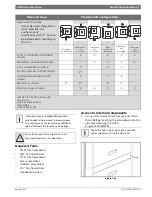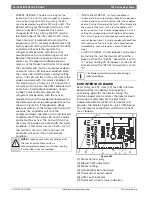
Duct System
|
29
SM Series Heat Pump
6 720 220 406 (2015/02)
Revised 02-15
A vertical air vent is sometimes required to avoid
air pockets. The length of the trap depends on the
amount of positive or negative pressure on the
drain pan. A second trap must not be included.
DUCT SYSTEM
A supply air outlet collar and return air duct flange
are provided on all units to facilitate duct
connections.
Fold the duct flange outwards along the perforated
line. Refer to unit Dimensional Drawings for
physical dimensions of the collar and flange.
(Pg#95 through Pg#95)
A flexible connector is recommended for supply
and return air duct connections on metal duct
systems. All metal ducting should be insulated
with a minimum of one inch duct insulation to
avoid heat loss or gain and prevent condensate
forming during the cooling operation. Application
of the unit to the no insulated duct work is not
recommended as the unit’s performance will be
adversely affected.
The factory provided air filter must be removed
when using a filter back return air grill. The factory
filter should be left in place on a free return
system.
If the unit will be installed in a new installation
which includes new duct work, the installation
should be designed using current ASHRAE
procedures for duct sizing. If the unit is to be
connected to existing duct work, a check should
be made to assure that the duct system has the
capacity to handle the air required for the unit
application. If the duct system is too small, larger
duct work should be installed. Check for existing
leaks and repair.
The duct system and all diffusers should be sized
to handle the designed air flow quietly. To
maximize sound attenuation of the unit blower, the
supply and return air plenums should be insulated.
There should be no direct straight air path thru the
return air grille into the heat pump. The return air
inlet to the heat pump must have at least one 90
degree turn away from the space return air grille. If
air noise or excessive air flow are a problem, the
blower speed can be changed to a lower speed to
reduce air flow.
PIPING
Supply and return piping must be as large as the
unit connections on the heat pump (larger on long
runs).
SM units are supplied with either a copper or
optional cupro-nickel condenser. Copper is
adequate for ground water that is not high in
mineral content.
In conditions anticipating moderate scale
formation or in brackish water a cupro-nickel heat
exchanger is recommended.
Refer to water quality table on page #30
Both the supply and discharge water lines will
sweat if subjected to low water temperature.
These lines should be insulated to prevent damage
from condensation. All manual flow valves used in
the system must be ball valves. Globe and gate
valves must not be used due to high pressure drop
and poor throttling characteristics.
Always check carefully for water leaks and repair
appropriately. Units are equipped with swivel
female pipe thread fittings. Consult Unit
Dimensional Drawings. (Pg#95 through Pg#95)
Flexible hoses should be used between the unit
and the rigid system to avoid possible vibration.
Ball valves should be installed in the supply and
return lines for unit isolation and unit water flow
balancing.
Supply air duct and return air duct flanges are
shipped unfolded with unit.
NOTE: Do not connect discharge ducts
directly to the blower outlet.
NOTE: Never use flexible hoses of a smaller
inside diameter than that of the fluid
connections on the unit.
Proper testing is recommended to assure the
well water quality is suitable for use with water
source equipment. When in doubt, use cupro-
nickel.
NOTE: Never exceed the recommended
water flow rates as serious damage or
erosion of the water-to-refrigerant heat
exchanger could occur.
Teflon tape sealer should be used when
connecting water piping connections to the units
to insure against leaks and possible heat
exchanger fouling.
NOTE: Do not overtighten the connections.
















































